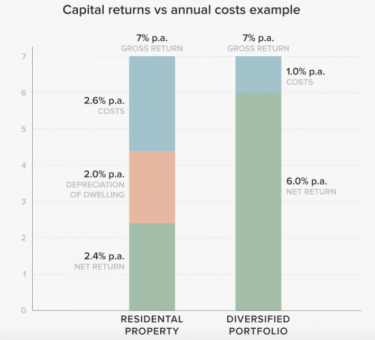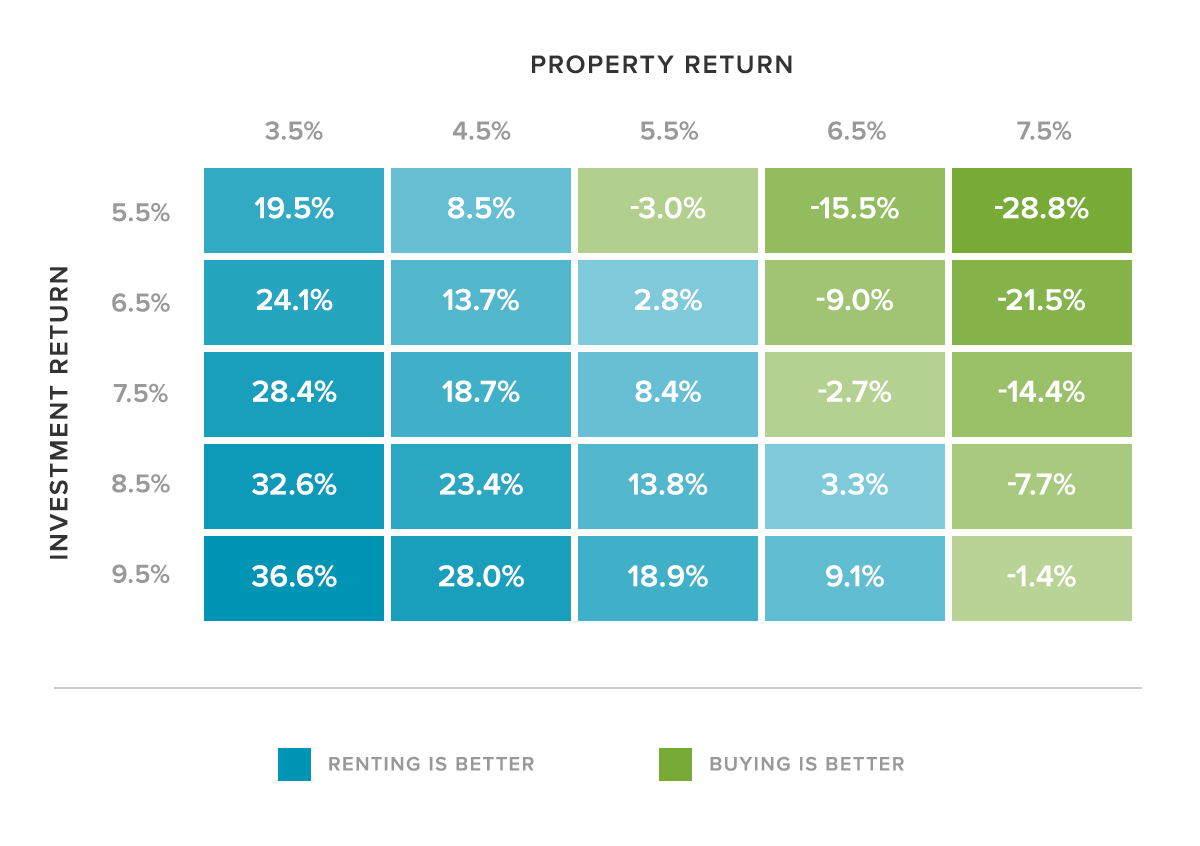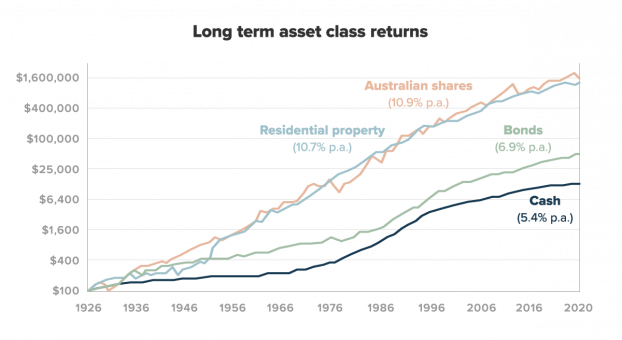The question of whether to rent or buy a property is one that is dominating dinner tables at the moment, especially between Millennials and older generations.
One generation will wheel out the adage that “rent money is dead money”, and anyone who rents when they could buy is simply paying someone else’s mortgage for them, but that will be met by a younger person pointing out how untethered the property market is from the average salary these days
The idea that renting is always better than buying is a popular myth perpetuated by plenty of people working in the real estate industry, but like all the best myths, it does have some truth to it.
After all, owning a home in Australia has generally been a good choice over the years – in fact, the reason so many struggle to get onto the market in 2024 is precisely because the value of a home has gone up so much relative to other parts of the economy. If you already own, house price rises are a good thing.
When house prices drop, however, renting starts to look attractive again because the main benefit of owning (capital growth) disappears.
Moreover, with the barrier to entry now much higher, the question of opportunity cost comes into consideration.
Buying a property might be a good way of growing wealth, but if it is out of reach, are there other options to get richer while still renting?
Like any financial decision, there are costs and benefits associated with both buying or renting.
Here we discuss some of the important pros and cons to consider when deciding whether to rent or buy and look at which one has really worked out better over the long term in Australia.
Pros of buying
1) Appreciation of property
It’s hard to miss the stories that house prices have been rising, and fast.
The median Sydney property rose more than 60% between July 2019 and July 2024 – that’s $700,000 in real terms in just five years – and other major cities like Melbourne and Brisbane have seen big gains too.
There are also good tax benefits for owning your own home over the long run because you don’t pay tax on capital gains on your primary place of residence.
But while house prices have consistently risen over the long-term, they can also have periods of weak growth or even fall in value. During the Global Financial Crisis in the late 2000s, house prices in the US fell by an average of 33.8%.
There’s little tax benefit in Australia of owning your home if prices fall because you can’t claim house price losses for your primary residence against your income.
Tax benefits from property tend to come from investment properties, largely through negative gearing.
Home owners also need to understand and be prepared to cope during periods of house price weakness.
2) You can leverage your investment
Buying property allows you to benefit from leveraging. Leveraging means borrowing money to finance an investment.
In the case of buying property, when you borrow money to buy a property, the bank lends a percentage of the purchase price to you as a mortgage.
In Australia, banks often lend a high percentage of the total value which means the use of borrowed money to invest in the property, or the leverage, can be quite high.
For instance, it’s typical to contribute 20% as a deposit while the bank covers the remaining 80% as a home loan, or an 80% Loan to Value Ratio (LVR).
So you buy a property for $1,000,000 with a deposit of $200,000 and borrow the remaining $800,000.
If you sell that property a year later for $1,100,000, the property itself has risen 10% in value but your return on investment is 50% (ignoring interest and other costs) since you have made $100,000 profit on the $200,000 original deposit.
That’s five times leverage because you earned a 5 times 10% return.
It’s worth noting that after transaction costs, interest and principal repayments, the actual return is likely to be much lower.
Also, the opposite would be true if the house price fell from $1,000,000 to $900,000. Your profit would be -50% – or worse after repayments and costs are accounted for.
3) Security and stability
Buying also provides some intangible benefits, like the security of not being displaced when the landlord decides to kick you out and the flexibility to renovate the property.
Cons of buying
1) Interest repayments.
If rent money is dead money then interest repayments are the same.
In 2020, you could have got a variable interest rate of 3%. This means that you would pay about $24,000 of interest each year on a $800,000 loan to buy a $1,000,000 house.
That’s almost the same amount as the $27,000 you would pay to rent a similar value property for a year.
The RBA estimates that long term variable mortgage rates have been about 6.20% over the long term, and they are slightly above that at time of writing in July 2024.
Someone taking out an $800,000 loan today at the first home loan average rate of 6.58% would see an interest bill of $52,640, or nearly twice as much as it was just three years ago.
2) Opportunity cost.
In simple terms, opportunity cost refers to the returns you could get elsewhere instead of putting down a house deposit.
That could be returns from investing into a diversified portfolio (historically 8-10% per year) or investing in your own business.
3) Ownership costs.
The transaction costs of buying and selling a property are high.
The RBA estimates that the costs of buying a house including stamp duty and other buying costs including conveyancing can be 4.3% of the total value of the property on average.
The cost of selling a house including real estate agent commissions and advertising costs add up to about 3.0%.

Combined, that makes the cost of moving in and moving out around 7% of the value of the property itself.
That number also ignores the ongoing running costs of owning a property which the RBA estimates to be at least 2.6% per year including council rates, repairs, depreciation, body corporate fees, water and insurance costs.
Some of these costs are generally borne by the landlord if you are a renter.
Pros of renting
1) You can get a return on your savings
Renting frees up your savings to earn a return elsewhere and depending on where those savings are invested, you may be able to earn a higher return than would be possible in property.
When interest rates are low returns from term deposits and savings accounts fall, and because of this, other investments like shares and bonds become far more attractive.For example, a balanced portfolio of shares and bonds has historically returned closer to 6-9% over the long-term.
2) Flexibility
Rent or buy could be framed as a question of stability v flexibility. In the current job market, many may feel like the ability to move is just as valuable as the security that comes with owning your own home. Renting, obviously, is very helpful in this situation.
3) Diversification of investments
When you buy your own home, most (if not all) of your eggs are in one basket.
Most of your total wealth could be riding on a single investment that can be impacted by a whole list of factors outside of your control.
Renting allows you to spread that risk across a much broader range of investments, with diversified portfolios such as those available from Stockspot able to spread risk across multiple investments.
Cons of renting
1) Rental costs
Renting can be expensive – especially if you’re renting in a city like Sydney or Melbourne. However, the flexibility of renting means that you can shop around for a property that will give you some left over money to invest.
2) No forced savings
Unlike buying where you are forced to contribute to a mortgage each month (which includes interest and principal repayments), renting doesn’t encourage forced savings. This can make it tempting for renters to spend spare cash rather than setting it aside.
However, budgeting apps like Pocketbook and investment apps like Stockspot make it easy for consumers to budget, save and invest – so keeping up with the returns of homeowners is becoming easier for renters in Australia.
Rent or buy: the results
As with any major financial decision, the choice whether to buy or rent is often dictated by the situation of the individual themselves.
The results show the difference in overall financial position based on different possible return rates for property and investing and assumed costs.
A positive number shows where renting is better than buying and the percentage amount reflects the difference in returns over 7 years.
Renting beats buying in 16 of the 25 scenarios and by 8.4% in our ‘base case’ of 5.5% property growth and 7.5% investment portfolio growth.

We have used a number of assumptions and different assumptions would impact these results. It should be noted that we have not considered the impact of ‘negative gearing’ which is a tax benefit that may be available if the property is held as an investment. Equally, franking credits on the share part of the portfolio have not been included in the investment returns. We also haven’t put a dollar value on the emotional benefits of owning or renting like security (owning) or flexibility (renting).
The case for buying
Over the last 5 years buying in major cities like Sydney and Melbourne has been a profitable strategy.
Sydney prices have increased about 97% since 2014 so combined with 5x leverage (80% LVR), investors in property would have enjoyed a return of nearly 300% on their initial investment. That’s huge!
What are the risks?
Buying with borrowed money magnifies both the good and bad. If you buy a Sydney property today with a 20% deposit (80% LVR), the property value would only need to fall 20% in value (i.e. where prices were less than three years ago) to completely wipe out the value of your investment.
This happened to many property owners in the US between 2007-2010 when property prices fell by 33.8% between April 2006 and December 2011.
American homeowners that ended up with zero or negative equity after the property collapse and couldn’t keep up with interest repayments simply ‘handed back’ their house keys to their mortgage lender and their houses were sold to cover the loan.
Where the funds recouped from sale were insufficient to cover the outstanding loan, the banks couldn’t go after the borrower for the subsequent loss because US loans are “non-recourse”.
In Australia however, mortgage loans are “recourse loans” which means that the banks can chase you for any loss they incur when foreclosing your loan. This puts Australian borrowers at more personal risk in the situation of a property bust.
The case for renting
Renting frees up your savings to invest elsewhere: either in term deposits, your business or a diversified investment portfolio.
Barring a huge spike in the rental market, it’s an attractive time to be renting and investing your savings somewhere else that could earn a higher return. This is why rent money isn’t really dead money – provided that savings are invested rather than spent.
Renting also enables you to avoid two big risks:
1) the risk of leverage which could mean your savings are overextended if property prices fall.
2) the risk of poor diversification. When you buy, all of your eggs are in one basket so your wealth is almost completely reliant on the success of one asset. Renting allows you to spread those risks much more widely.
Rent or buy: Stockspot’s conclusion
Our analysis suggests renters are likely to be better off than property owners over the next seven years based on long-term assumptions.
The market cycle, property yields and the current payback period are all suggesting that now isn’t the best time to be buying.
Prospective property buyers should think twice before jumping at the opportunity to sink their savings into a house. Leverage and poor diversification make home ownership much riskier than many people assume.
The other risk is the unpredictability of interest rates.
The Reserve Bank of Australia (RBA) once said that one-third of borrowers “have either no accrued buffer or a buffer of less than one month’s repayment”. This puts owners on dangerous footing in a period of higher interest rates
Historically, having a mortgage has forced people to save, but technology now assists everyone to budget and invest.
Over the last 60 years, statistics show that, rent or buy, whichever decision people have made has resulted with them in roughly the same place.
This, of course relies on renters being disciplined about investing their savings in a portfolio that will deliver them consistent returns.

Sources: ABS, REIA, Global Financial Data, AMP Capital
Rent or buy assumptions
Buying
| Factor | Long term assumption | Explanation |
| Mortgage interest rate | 6.20% per year | Current variable interest rates are around 6.5%, which is not too far from the 6.20% that the RBA uses in their long term assumptions. |
| Property appreciation | 3.5% to 7.5% per annum | The average appreciation rate since 1955 was 5.5% so we have looked 2% either side to account for the potential for a weak or strong property market. |
| Property ownership costs | 2.60% per year | This is an RBA estimate which includes depreciation, council rates, body corporate fees, water and insurance. |
| Property transaction costs | 6.0% | This is conservative compared to the RBA estimate of 7.30%. We have assumed 4% purchase costs which includes stamp duty/conveyancing and 2% sales costs which included real estate agent commissions and advertising costs. |
| Loan to Value Ratio (LVR) | 70% | This is roughly the national average which varies from 65% to 75% by state. |
| Loan term | 30 years | Typical mortgage loan term |
Renting
| Factor | Long term assumption | Explanation |
| Rental yield | 4.20% per year | Long term average since 1955 has been 4.20% compared to 3.90% now. |
| Rent increases | 2.80% per year | Assumes rents increase in line with the RBA goal inflation rate. |
| Investment portfolio return | 5.5% to 9.5% per annum | The 10 year rolling average return of a balanced portfolio after fees was about 7.5%. We have looked 2% either side to account for the potential for a weak or strong stock market and bond market. |
This article was originally posted in April 2015, was re-published with updated information in February 2021 and again with further updates in July 2024.

